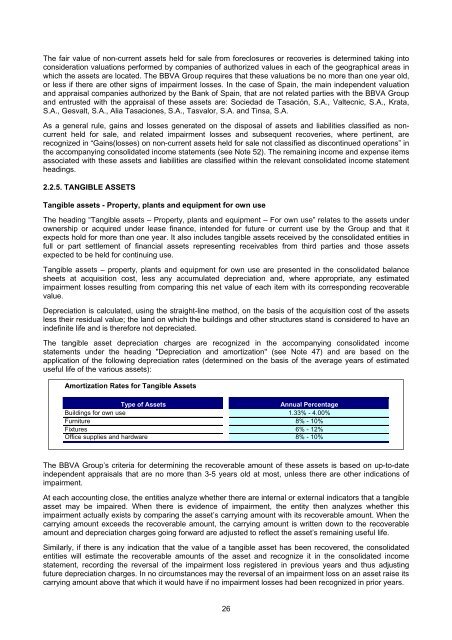BANCO BILBAO VIZCAYA ARGENTARIA, S.A. AND ... - BBVA
BANCO BILBAO VIZCAYA ARGENTARIA, S.A. AND ... - BBVA
BANCO BILBAO VIZCAYA ARGENTARIA, S.A. AND ... - BBVA
You also want an ePaper? Increase the reach of your titles
YUMPU automatically turns print PDFs into web optimized ePapers that Google loves.
The fair value of non-current assets held for sale from foreclosures or recoveries is determined taking into<br />
consideration valuations performed by companies of authorized values in each of the geographical areas in<br />
which the assets are located. The <strong>BBVA</strong> Group requires that these valuations be no more than one year old,<br />
or less if there are other signs of impairment losses. In the case of Spain, the main independent valuation<br />
and appraisal companies authorized by the Bank of Spain, that are not related parties with the <strong>BBVA</strong> Group<br />
and entrusted with the appraisal of these assets are: Sociedad de Tasación, S.A., Valtecnic, S.A., Krata,<br />
S.A., Gesvalt, S.A., Alia Tasaciones, S.A., Tasvalor, S.A. and Tinsa, S.A.<br />
As a general rule, gains and losses generated on the disposal of assets and liabilities classified as noncurrent<br />
held for sale, and related impairment losses and subsequent recoveries, where pertinent, are<br />
recognized in “Gains(losses) on non-current assets held for sale not classified as discontinued operations” in<br />
the accompanying consolidated income statements (see Note 52). The remaining income and expense items<br />
associated with these assets and liabilities are classified within the relevant consolidated income statement<br />
headings.<br />
2.2.5. TANGIBLE ASSETS<br />
Tangible assets - Property, plants and equipment for own use<br />
The heading “Tangible assets – Property, plants and equipment – For own use” relates to the assets under<br />
ownership or acquired under lease finance, intended for future or current use by the Group and that it<br />
expects hold for more than one year. It also includes tangible assets received by the consolidated entities in<br />
full or part settlement of financial assets representing receivables from third parties and those assets<br />
expected to be held for continuing use.<br />
Tangible assets – property, plants and equipment for own use are presented in the consolidated balance<br />
sheets at acquisition cost, less any accumulated depreciation and, where appropriate, any estimated<br />
impairment losses resulting from comparing this net value of each item with its corresponding recoverable<br />
value.<br />
Depreciation is calculated, using the straight-line method, on the basis of the acquisition cost of the assets<br />
less their residual value; the land on which the buildings and other structures stand is considered to have an<br />
indefinite life and is therefore not depreciated.<br />
The tangible asset depreciation charges are recognized in the accompanying consolidated income<br />
statements under the heading "Depreciation and amortization" (see Note 47) and are based on the<br />
application of the following depreciation rates (determined on the basis of the average years of estimated<br />
useful life of the various assets):<br />
Amortization Rates for Tangible Assets<br />
Type of Assets<br />
Annual Percentage<br />
Buildings for own use 1.33% - 4.00%<br />
Furniture 8% - 10%<br />
Fixtures 6% - 12%<br />
Office supplies and hardware 8% - 10%<br />
The <strong>BBVA</strong> Group’s criteria for determining the recoverable amount of these assets is based on up-to-date<br />
independent appraisals that are no more than 3-5 years old at most, unless there are other indications of<br />
impairment.<br />
At each accounting close, the entities analyze whether there are internal or external indicators that a tangible<br />
asset may be impaired. When there is evidence of impairment, the entity then analyzes whether this<br />
impairment actually exists by comparing the asset’s carrying amount with its recoverable amount. When the<br />
carrying amount exceeds the recoverable amount, the carrying amount is written down to the recoverable<br />
amount and depreciation charges going forward are adjusted to reflect the asset’s remaining useful life.<br />
Similarly, if there is any indication that the value of a tangible asset has been recovered, the consolidated<br />
entities will estimate the recoverable amounts of the asset and recognize it in the consolidated income<br />
statement, recording the reversal of the impairment loss registered in previous years and thus adjusting<br />
future depreciation charges. In no circumstances may the reversal of an impairment loss on an asset raise its<br />
carrying amount above that which it would have if no impairment losses had been recognized in prior years.<br />
26
















